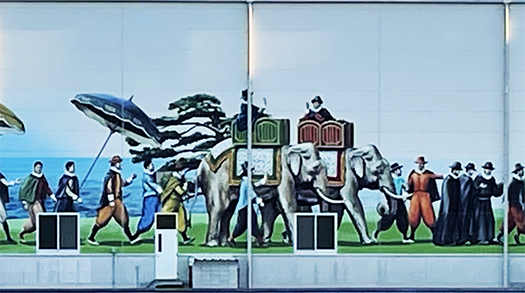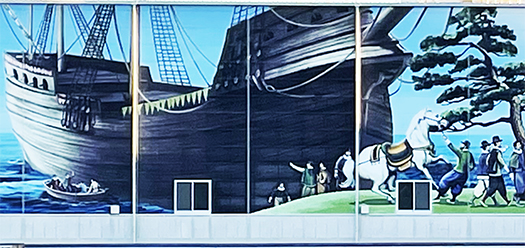

わたしは関西に出掛けるときには、基本的には堺の町に逗留することにしています。京阪神地区をあちこち、さらに奈良や兵庫県深奥部などにも距離的に行動しやすく、適度に田舎感があって「関西でのホームタウン」として親近感を持っています。
そういう認識を持つに至ったきっかけには、子どもの頃からの歴史好きがあって、こどものときに見ていた信長ストーリーで、若い信長がまるで修学旅行のように堺の町に「見聞を広めた」様子が描かれていて、そういう信長の心事に強い共感を持っていたことが大きいと思っているのです。
人間誰でも、その青春期に体験したことと言うのは強く影響を受け続けるものだろうし、歳を重ねる毎にそういう心理がより熟成して、浪漫化していって珠玉のように思えていくものなのでしょう。
写真は大好きな大浜公園から見える工事用壁面パネルの描画。
臨時的に工事現場を覆う用途の壁面ですが、最近の建築人のマナーとして、その建てられる地域の人びとに配慮して、そこでの歴史をリスペクトするような画題で壁画面としている場合が多い。そういうなかでもこの堺の町の壁画面には感服した次第。
先述したような信長の時代の堺の状況が白日夢のように現出している(笑)。
はるかな戦国の時代にこのように堺の町を闊歩していた異人さんたちが、最新の西洋の技術を交易していた。最先端資本主義である堺の商人たちは、その応接に対応して日本社会への普及拡散に努めた。

幕末・明治以降にも日本は同様の経験を持つのだけれど、戦国期日本はこういった活発な交易交流の積層の結果、キリシタンという精神文化への強い拒否反応から鎖国に至る。一方、幕末明治からの積極的導入からの社会の結末として、敗戦経験があるのだろうと思います。
そういった民族としての西洋文化との出会い、そのさまざまな紆余曲折を経てなお、やはり青年・信長のピュアな驚きの心情を強く思わされる。交易ということでは中部日本の中枢でもあった尾張経済圏を掌握していた織田家の血脈として、信長にしてみても堺での体験は格別だっただろう。さまざまに想像を巡らせていたことが、この堺ですべてが明瞭になり、具体的には鉄砲という最新兵器を制するものが日本を統一できると確信し、そのための原資として活発な重商主義路線を政治選択したのだろう。
日本がたどった歴史のひとつの起点として、こういう堺の光景はわたしのような北海道人にはまぶしく見えてくる存在。であるのに、現代では京阪神に中心軸が移って行って、堺の町はなかば忘れ去られている。しかしそういったことも、むしろありがたく感じさせられる。ごくふつうの一地方性のなかに収まっている雰囲気が、無上に好きなのであります。
English version⬇
Nobunaga’s view of Sakai during the Warring States Period
Nobunaga as a symbol of the strong Japanese curiosity discovered by the West in the Age of Discovery. Nippon adopts the landscape of the first source of encounter of civilizations as a construction shielding panel mural. …
Whenever I travel to the Kansai region, I generally stay in the town of Sakai. It is within easy reach of many places in the Kyoto-Osaka-Kobe area, as well as Nara and deep into Hyogo Prefecture, and has a moderately rural feel that makes me feel close to Sakai as my “home town in the Kansai region.
I have had a love of history since I was a child, and the story of Nobunaga Nobunaga that I watched as a child depicted the young Nobunaga “spreading his knowledge” of Sakai as if he were on a school excursion, and I believe that I was strongly motivated by my sympathy for Nobunaga’s thoughts and feelings. I believe that it was largely due to his strong sympathy for Nobunaga’s heart and mind.
I believe that what we all experience in our youth will continue to have a strong influence on us, and as we get older, our psychology matures and becomes more romanticized, making us feel as if we are a gem.
The photo is a drawing of a construction wall panel that can be seen from my favorite Ohama Park.
Although these wall panels are used to temporarily cover construction sites, in recent years architects often use wall panels with themes that respect the history of the area in which they are built, in consideration of the people living in the area. In this case, I was impressed by the wall paintings in Sakai.
As mentioned above, the situation in Sakai during the reign of Nobunaga Nobunaga appears as if in a daydream (laugh).
In the far-off days of the Warring States period, the foreigners who strolled around Sakai in this manner were trading in the latest Western technology. The merchants of Sakai, the most advanced capitalism, responded to their reception and worked to spread and diffuse the technology to Japanese society.
Japan had a similar experience after the end of the Edo period and the Meiji period, but as a result of these layers of active trade exchanges, Japan during the Warring States period was forced to close its borders due to a strong rejection of the spiritual culture of Christianity. On the other hand, I believe that the end of the war was the result of a society that actively introduced Christianity from the end of the Edo period and the Meiji era, and that it experienced defeat.
Such encounters with Western culture as a people and its various twists and turns still strongly remind us of the pure and surprising feelings of the young man Nobunaga. As a member of the Oda family, which controlled the Owari economic zone, the center of Central Japan in terms of trade, Nobunaga must have had an exceptional experience in Sakai. He was convinced that he would be able to unify Japan if he controlled the latest weaponry, specifically guns, and he chose an active mercantilist policy as a source of funds to achieve this goal.
As the starting point of Japan’s history, this scene in Sakai is a dazzling sight for a Hokkaido person like myself. Yet, today, with the central axis of Japan’s history shifting to the Kyoto-Osaka-Kobe area, the town of Sakai has been somewhat forgotten. But this is something to be thankful for. I am supremely fond of the atmosphere of the town, which is contained within a very ordinary locality.
Posted on 10月 24th, 2023 by 三木 奎吾
Filed under: 歴史探訪







コメントを投稿
「※誹謗中傷や、悪意のある書き込み、営利目的などのコメントを防ぐために、投稿された全てのコメントは一時的に保留されますのでご了承ください。」
You must be logged in to post a comment.